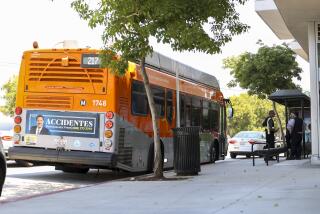Keep California’s bullet train on track
California’s proposed bullet train took another shot this week when an independent review panel issued a report concluding that the project wasn’t financially viable. This followed negative reviews from the state auditor, the inspector general, the legislative analyst and the UC Berkeley Institute of Transportation Studies.
It’s hard to argue with such a distinguished group of experts, whose logic is unassailable. No source of funding has been identified for the project beyond the initial segment in Central California, they pointed out. Moreover, the location of that segment poses grave risks; if it were built near Los Angeles or San Francisco, it would still have major public benefits even if no more money could be found to extend it, but a spur from Fresno to Bakersfield alone would be a costly train to nowhere.
The trouble with this kind of expert analysis, though, is that it seldom takes politics into account. Planners didn’t have much choice but to place the initial segment where they did, because to qualify for federal stimulus money they had to guarantee that construction would begin quickly, and the Central Valley portion was thought to be the only part of the line that would be ready to meet Washington’s deadline. No source of future funding, such as a higher gasoline tax, has been proposed because the economy is rotten and voters would be unlikely to approve it right now. So does that mean the whole thing should be scrapped?
The project is unquestionably risky, far more expensive than voters were told it would be when they approved nearly $10 billion in bonds to build it in 2008, and unlikely to be finished until years later than promoters had suggested. Polls show that the public is turning against it, and if new information emerges forecasting more serious troubles, even we might be persuaded to dump it. But we’re not there yet, especially because the latest report, from the California High-Speed Rail Peer Review Group, doesn’t tell us anything we didn’t already know.
The project’s current political ills remind us of the firestorm that erupted over L.A.’s subway, when sinkholes appeared on Hollywood Boulevard, construction mismanagement led to cost overruns, and voters became so disillusioned with subways that they approved a measure in 1998 forbidding the expenditure of county sales tax money to pay for them ever again. A decade later, they realized how shortsighted they had been; failure to complete a subway to the sea contributed to worsening gridlock on the Westside, and the subway had such clear benefits for riders that its construction troubles were largely forgotten. The result: County voters approved a new measure in 2008 to raise the sales tax to pay for, among other things, more subway construction.
The same phenomenon is already happening in Boston, home of the nation’s most expensive transportation project. The Big Dig highway tunneling scheme was a political catastrophe a few years ago, what with mistakes that prompted severe delays and caused the price tag to skyrocket. Although the Big Dig is nobody’s idea of the right way to build infrastructure, Bostonians are now reveling in a downtown park built on what used to be an expressway, and a tangled traffic mess has been unsnarled. In a few more years, the headaches will probably have been forgotten.
Worthwhile things seldom come without cost or sacrifice. That was as true in ancient times as it is now; pharaoh Sneferu, builder of Egypt’s first pyramids, had to try three times before he got it right, with the first two either collapsing under their own weight or leaning precipitously. But who remembers that now? Not many people have heard of Sneferu, but his pyramids and those of his successors are wonders of the world.
The point is, you can take the long view or the short view toward the bullet train. The expert panels are taking a short view; we prefer the long. In the end, if Californians have the patience and the political will to stick with it, they’ll have a project with extraordinary environmental, economic and transportation benefits. If they don’t, they’ll have worsening congestion, rising pollution and soaring transit expenses as gasoline prices continue their inevitable rise. We like the first vision of the future better.
More to Read
A cure for the common opinion
Get thought-provoking perspectives with our weekly newsletter.
You may occasionally receive promotional content from the Los Angeles Times.










